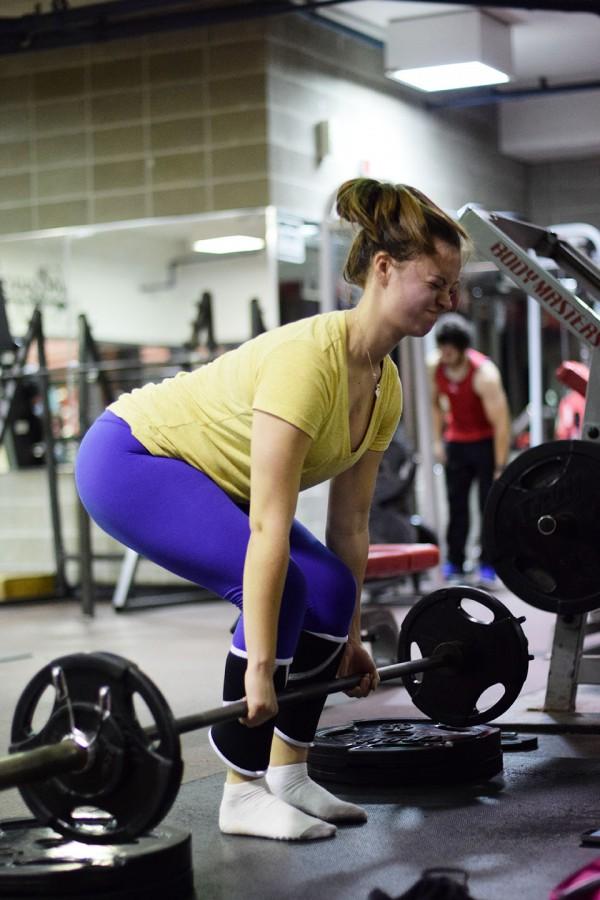Raising the bar
For many women in college starting out implementing an exercise regime, or even those who have been working out for a long time, the weight room can be an intimidating or uncomfortable place
March 10, 2016
Even though she knows what she is doing, Lily Cordingley, mass communication freshman, said she feels unwelcome in the weight room.
“I know how to use the machines, but the way boys look at you skeptically makes you feel like you’re doing it wrong, even when you know you aren’t,” Cordingley said.
For Dari Zeltser, mass communication freshman, she said she is unsure of how to use the machines, and doesn’t like the atmosphere of the weight room.
“There are so many boys there, and they’ve been there a lot, and are used to being there. It’s like it’s their space, and there’s no space there for me,” Zeltser said.
This discomfort can keep women from seeking guidance in how to correctly use the machines, risking muscle strain or injury by using them with improper form. It can also keep them out of the weight room altogether, and cause them to miss out on the benefits that come with weight lifting.
Megan Byas, Loyola fitness coordinator, has started a program called Women on Weights that aims to teach the form and technique of lifting and how to build an effective routine.
“It’s important for muscular stability. It’s important for nerve function. It’s important for completing day-to-day tasks, and it’s important that young adults learn now how to apply physical fitness to their lifestyles, so that in the future they won’t have to make drastic lifestyle changes to avoid the diseases and illnesses that physical fitness can help prevent,” Byas said.
While women can use the same exercises that work for men, they can benefit from taking into consideration the differences in their body structures while coming up with a personal fitness routine, Byas said.
“Women tend to be weaker in the upper body. We tend to have weaker backs, and our estrogen- to-testosterone ratio is different, which means we have more body fat and it’s harder to build muscle. It takes more time and it takes more effort,” Byas said. “Things like that I want to communicate through the program and let women know the importance of building a strong core and having strong posture.”
Byas said regardless of the gender, students should prioritize making sure that they are going to the gym regularly.
“It’s a gradual process for anybody getting started in weight training. There’s no particular exercises that I would say would be better for women. A lot of women can do the same back exercises, chest exercises, leg exercises that men can do—squats are universal, lunges are universal, a lot of exercises are universal and can be applied for anyone, it’s just whatever works for any particular person, regardless of gender,” Byas said.
Byas said she is excited about the way the program will be able to help women on campus.
“My purpose and mission for the Women on Weights program is to increase the knowledge of women in regards to physical fitness, the proper use of equipment, the proper forms and postures and just give them guidance to prepare them for working out on their own,” Byas said.








Patrick Bowden • Mar 28, 2016 at 1:40 am
There is a lot of useful information in this article, but the one thing that sticks out the most to me is the concern surrounding how others are looking at people in the weight room… Don’t concern yourself with others just work on your goals. Gym time and exercise are your personal investments. If you’re in the gym that means you have something “to some degree” in common with everyone else in the gym, you want to improve. Ask for some pointers if you feel a little lost. Don’t be rude if a stranger asks if you would like a pointer that could help prevent you from ripping a rotator cuff. And know that it takes time!!! Good diet and persistence can shorten that time substantially though. And for some of us we like to obnoxiously look at our gains in the mirrors to acknowledge progress… well, and some vanity. Anyways, I take my regiments pretty serious and when someone asks me for insight I take that pretty serious too.
“Success is not a result of spontaneous combustion. First you must set yourself on fire.” – Fred Shero